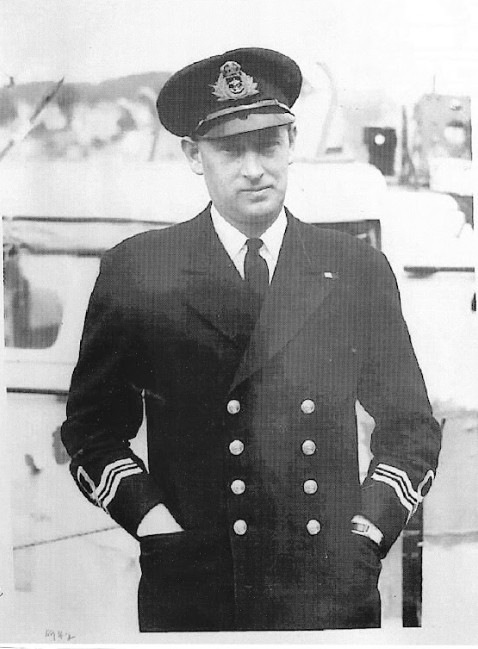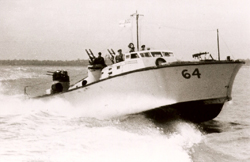

Lieutenant Commander Robert Peverell Hichens DSO* DSC** RNVR or ‘Hitch’ as he was known to his colleagues, was a Falmouth-based solicitor with a keen interest in sailing and motor racing who had joined the RNVR in 1936.
At Dunkirk he found himself closely involved with the small boats and yachts evacuating troops from the jetty, where he won his first DSC. He joined Coastal Forces in 1940 and led the way for RNVR officers in that field.
The Nore 19 November 1941
Hitch received his second DSC for an attack on E boats in the Nore area, in which he captured an E Boat.
‘I think one of the most lovely sights I have ever seen is a gunboat unit at speed in moonlight, with the white pluming wakes, the cascading bow waves, the think black outlines of the guns starkly silhouetted, the figures of the gunners motionless as though carved out of black rock, all against the beautiful setting of the moon-path on the water.’
That night, Hichens and the available boats from the 6th Flotilla sailed from Felixstowe to intercept a pack of E boats hunting along the east coast convoy route, roughly 150 miles away. After an hour, he lost an engine and was limited to 18 knots – an opportunity to return if he had taken it. Hitch kept going…
At 0200hrs they stopped to listen for the enemy. It was always more effective to hear them several miles away rather than see them at a few hundred yards. They waited, and three hours later, they heard them. Cursing their lack of speed they waited as the unsuspecting E Boats came closer. It was misty and there was no moon. As the noise source moved, so the team started to plot the E boats likely course and speed: they would have one chance to intercept at this reduced speed.
Eventually they made their move, staring their engines and racing off at a slightly sedate 18 knots. Then they stopped again – having changed the angle of the noise they had given themselves a much better idea of the enemy’s position. Moments later the got underway again. Moments later they saw the outline of a hull in the mist. Was it the target, or a British Special Ops boat returning from a mission? Hitch fired a recognition flare and the saw six E boats clustered together moving very slowly.
Immediately they engaged, closing to within 20 yards and inflicting significant damage on the first three boats. The fourth had time to react and caused a fair bit of damage to Hitch’s boat – miraculously no casualties. The German boat caught fire down aft, but somehow escaped.
‘It is hard to describe the confusion of such an engagement. The pitch darkness, the swift-moving hulls, lost to sight almost as soon as seen, the brilliant stream of light from the tracer criss-crossing like comets in every direction; above all, the incessant noise.’
As the chaos subsided, the British boats stopped to listen again. They heard something and set off in pursuit again, all the time wondering whether their remaining weapons would have any effect. They found an E boat lying quietly. Hitch ordered his boats to attack with depth charges. You have to do this a full speed to avoid blowing off your own propellers, so whilst Hitch’s boat circled slowly, his colleague turned away before circling back at 40 knots and firing his charges just in front of the eerily silent E boat. She was stopped and low in the water. Were they all dead?
Hitch decided to board her. MGB 67, which had conducted the depth charge attack, reported that three other E boats were spotted beating a hasty retreat and it soon became clear that they had taken the crew off this one and left her to sink. Carefully, they made their approach and put a boarding party onto her. Unable to prevent her from sinking, they removed as much of value as they could – it turned out that the Germans had been eating supper when Hitch had surprised them.
His boats withdrew, back to Felixstowe to repair and rearm. Later that day they sailed for the Dutch coast…
Victor Stay, his engineer, was mentioned in Dispatches.
The Nore 19 December 1941
Mentioned in Dispatches for engagement with E boats. Watch this space for the full story…
Ostend 21 April 1942
Awarded the DSO or an action with E Boats off Ostend. Watch this space for the full story…
Alderney 14 July 1942
In July 1942 he won a bar to his DSO for a successful attack on a convoy of trawlers protecting an oil tanker off Alderney. Petty Officer Victor Stay, his chief engineer, was Mentioned in Dispatches.
Cherbourg 1 August 1942
Two weeks later he was in action again hunting E boats off the entrance to Cherbourg. Following an intelligence tip off, he had led four gunboats across the Channel from Dartmouth at 40 knots in the dark, only to stop a couple of miles north of the breakwater and hear the sound of the enemy’s engines entering harbour – they were five minutes late. As they pondered their next move, they realised that there were in fact two groups of E boats and the second group were sitting just to the east, no doubt waiting for orders to enter harbour.
Without hesitation, he led his group of four boats at full speed straight towards the group of stationary Germans. As they made their approach, they passed a German torpedo corvette, but unable to inflict much damage on him, they carried on towards their intended targets in a tight formation. When they were barely 100 yards away, all four opened fire on the last boat in the line, with devastating effect. Hichens turned and ran down the line of stationary E boats, who struggled to return fire – they must have thought they were home safe and caught off-guard. In the ensuing eight minutes of chaos, two E boats caught fire. The others were damaged.
When the shore batteries realised what was happening, they opened up with a barrage of starshell and tracer, lighting the place up like Guy Fawkes Night. The torpedo corvette joined in, but Hitch and his boats managed to escape to the north. They turned and watched as the Germans proceeded to fire at each other, unsure where the enemy lay. The British boats escaped with minor damage and a couple of light injuries. Hitch and three of his crew were mentioned in Dispatches.
The Nore 14 September 1942
Hitch was awarded his third DSC for this action. Petty Officer Victor Stay won the DSM. Watch this space for the full story…
A few weeks later his ship was lost to enemy fire, but he survived. In February 1943 he was recommended for the Victoria Cross following an action in which he put his ship alongside a stricken MGB that was on fire in order to rescue the crew. Both ships caught fire and the men were lucky to survive. Hichens felt that he should not be awarded this medal because he had endangered two of the boats trying to rescue his friends, and the nomination was parked.
On 12 April 1943, whilst successfully engaging German minelayers off the Belgian coast, his ship was hit and he was killed outright. He received his third ‘mentioned in despatches’ posthumously for this action.
Hitch is the most decorated RNVR officer of all time. Since the demise of the Navy Club in Mayfair, his portrait has hung in the Army and Navy Club in Pall Mall.
His book ‘We Fought Them in Gunboats’ was written whilst he was serving at sea and is unfinished as a result. The Admiralty censored the first edition very heavily – he was not always a fan of the senior leadership, but in 2023 a full version was published with a foreword by his granddaughter, Tamsin Clive. It makes remarkable reading. So does his biography ‘Gunboat Command’ written by his son Anthony, who is a Trustee of the Coastal Forces Heritage Trust.
